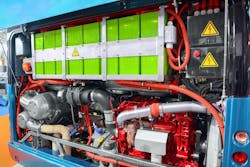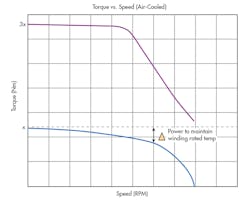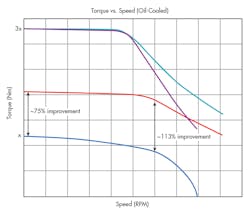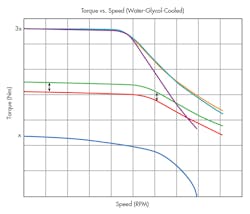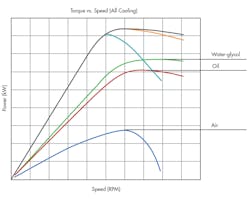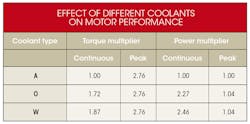Optimize Your Vehicle by Cooling Electric Motors and Generators
Download this article in PDF format.
Plug-in electric vehicles for passengers continue to become more mainstream within the automotive market, and the shift in that direction shows no signs of slowing down. In fact, Bloomberg New Energy Finance’s 2017 Long Term Electric Vehicle Outlook forecasts that by 2040, 54% of new car sales and 33% of the global car fleet will be electric vehicles. Growth projections for the numbers of hybrid electric vehicles are similarly vigorous. However, what may be less obvious is the similar trend in commercial vehicle markets, including off-highway/construction equipment, agricultural vehicles, turf vehicles, and vehicles used in mining and forestry.
When developing a new electric or hybrid electric vehicle, one of the biggest design challenges is developing a thermal-management system for the vehicle.
Manufacturers of these vehicles are increasingly eager to develop and launch hybrid and electric products in an effort to reduce fuel consumption, particulate emissions, and noise levels, while improving vehicle performance, efficiency, reliability, and lifespan. Cooling an electric motor boosts its performance, allowing for a smaller motor to be used, which in turn lowers vehicle weight and increases energy efficiency.
Sizing the motor depends directly on how it is cooled. This article presents an overview of some of the thermal-management considerations involved in selecting the most appropriate cooling approaches for electric traction motors and auxiliary function motors for new off-highway electric and hybrid electric vehicles.
When developing a new electric or hybrid electric vehicle, engineers must weigh a variety of design tradeoffs and considerations when selecting electric motors/generators. One of the biggest challenges is developing a thermal-management system for the vehicle that meets the overall project’s space, weight, and cost targets. Depending on the vehicle design, the system may need to cool an internal combustion engine (ICE), traction motors/generators, inverters, batteries, and, in some cases, auxiliary function motors to power hydraulics, air-conditioning compressors, and brake compressors.
Early in any technical discussion with a motor/generator specifier, the conversation typically moves quickly to thermal considerations. Where will the motor/generator be mounted? What is the temperature of that area? How will the motor/generator be mounted? What is the planned cooling system? What level of airflow will be available? What’s the planned fluid temperature and flow?
Taking the time to answer these questions fully and accurately makes it simpler to size the motor/generator appropriately. It also allows for making more informed decisions on the best motor/generator selection for the application.
Cooling PMAC Motors
Permanent-magnet alternating-current (PMAC) motors are widely used in electric and hybrid vehicles. They serve the primary purpose of taking electrical energy and transforming it into mechanical energy, typically rotary. Three major areas must be considered when selecting PMAC motors: peak torque, continuous torque, and speed. The combination of these three also affects the motor’s peak and continuous power output.
In most cases, the specifications in a motor catalog provide all of the information needed to select and size a motor. However, when higher output performance is required and space is limited, paying additional attention to cooling can make a big performance difference.
To understand the potential cooling cost/performance tradeoffs with electric motors, it’s essential to evaluate the various factors that influence how much additional performance can be extracted from such a motor. Although these factors also include coolant type, temperature, flow rate, viscosity, and the thermal resistance from winding to the case, this discussion will address only the type of coolant used.
Air Cooling
1. Effect of air cooling on a PMAC motor.
Air cooling is the simplest form of cooling. In the example illustrated in Figure 1, there is no air movement; the heat that’s generated by the motor is conducted from the hot parts to the cooler housing and heat sink (mounting surface).
For any continuous torque value (x), the peak torque is three times the torque value (~3x Nm). As the motor speed rises, the temperature builds up in the stator due to additional moving/spinning losses. The current from the motor controller must be decreased to keep the temperature of the windings at a safe point. Note the steep decline in continuous torque needed to maintain the windings at rated temperature. If the stall current to output x Nm was pumped into the motor at higher speeds, the motor would overheat and eventually fail.
Oil Cooling
2. Oil-cooled motor performance.
Superimposing the results of oil cooling onto the same graph illustrates just how much oil cooling can boost motor performance (Fig. 2). Note that oil cooling the motor did not affect peak torque, but it did have a dramatic impact on the continuous stall torque, which rose to 1.75x Nm—roughly a 75% improvement over the air-cooled version. And, as the motor RPM increases, the spinning losses continue to produce heat in the windings. Fortunately, though, the oil can extract that heat from the motor. There’s also a 113% improvement in operating torque at higher speeds. The oil-cooled motor has a much larger continuous operating region.
Water-Glycol Cooling
3. PMAC motor performance with water-glycol cooling.
Using a combination of water and glycol as a coolant (Fig. 3) does not affect the peak torque. However, it does offer a modest (~10%) advantage over oil cooling in terms of continuous torque performance because the water can absorb more heat than oil.
Power – All Three Coolant Types
4. Effect of coolant type on continuous power and peak power of a PMAC motor.
Figure 4 shows the impact of all three coolant types on continuous power (significant) and peak power (insignificant, except for a small increase that is beyond the scope of this discussion). Note that cooling not only boosts power at the same point, but it enables the motor to spin faster, allowing for an extended operating range. With the right gearing, this can also make a much more significant impact in torque output.
Selecting a motor that’s able to employ liquid cooling effectively can add significant continuous torque and power performance to the motor—at both stall and rated speeds—and may lead to much smaller motors. The table summarizes the influence of coolant type on motor performance.
Off-Highway Vehicles
Some off-highway vehicles have intermittent duty cycles. If weight and space aren’t significant concerns, and there’s a preference for a simplified vehicle architecture, then an air-cooled motor/generator can be sized to achieve those goals. Understanding where the electric motor/generator will be mounted, if exposed to heat from other sources (e.g., an ICE), and if it can be cooled by some other means such as conduction, air flow from the vehicle’s motion, or coolant fans, are all factors in correctly sizing the motor/generator.
If the vehicle has high continuous operating regions during motor/generator operation, and if power density, weight reduction, and range are primary design goals, a water- or oil-cooled motor/generator will typically help meet vehicle performance objectives. On average, an oil-cooled motor/generator will increase the continuous stall torque performance of the motor/generator by 75%, and a water/ethylene glycol-cooled version will increase it by 85% over an equivalent air-cooled motor/generator. This offers the vehicle designer greater flexibility in packaging the vehicle to meet weight budgets.
Another potential advantage of designing in oil- or water/ethylene-glycol-cooled options is a motor/generator with less overhung mass and smaller and lighter mounting brackets, which can offset the weight of any coolant plumbing needed for the motor/generator. However, determining which coolant method to use is far from a simple process.
Battery Electric Vehicles
For battery-powered electric vehicles, if the designer plans to use advanced-chemistry lithium-ion batteries that must be actively liquid-cooled, then it makes sense to develop a cooling system that incorporates the inverters and the motor/generator(s). In most cases, a motor/generator can accept the coolant out of the inverter as the inlet. Although the coolant is hot, it is cool enough to cool the motor. Maximizing the power density of the motor/generator allows for a lighter-weight machine, higher performance, and efficiency. As a result, the designer can make decisions on reducing battery size to meet cost targets or increasing battery size to extend range.
In a simple battery electric vehicle, adding cooling might raise the cost of the vehicle or make it too complex. If lower-cost battery technology is being used, then air-cooled inverters and air-cooled motor/generators might be the most cost-effective option.
Whenever possible, when designing an off-road electric or hybrid electric vehicle, it’s advisable to compare the benefits of various cooling methods for the motor/generator. With just a moderate amount of the right type of cooling, motors/generators can produce significantly higher continuous torque levels. The right cooling can even make it possible to select a smaller motor/generator while still meeting the vehicle’s overall performance goals.
Hybrid Electric Vehicles
Multiple options are available to cool the motors/generators used in off-highway hybrid electric vehicle applications. For example, if the vehicle will have sufficient hydraulic fluid on board to operate auxiliary functions, then it can be used as a coolant for the motor/generator and any auxiliary function motors. A separate water-ethylene glycol circuit can be downsized to handle a smaller displacement ICE. The engine coolant is too hot to cool inverters or lithium-ion batteries effectively, so they may need to be air-cooled.
If the vehicle does not have an abundance of hydraulic fluid, water-ethylene glycol is the best choice for the motor/generator. Incorporating the motor/generator into the ICE engine cooling circuit is a very effective solution for a high-performance motor/generator.
Creating a separate cooling circuit for the hybrid electric components—typically the batteries, inverters, and motors/generators—is yet another option, although the batteries are sometimes put on a separate coolant circuit of their own to reduce potential failure modes. The upside of this method is that the coolant can be at a lower temperature versus the internal combustion-engine circuit, which enables a higher power density out of the motor/generator.
For many motor/generator specifiers, the first step in the process should be to talk with a motor supplier for guidance on cooling options. A few suppliers have mobile systems engineers on hand and offer proprietary motor-sizing software tools that enable modification of the thermal inputs, such as coolant type, coolant inlet temperature, and coolant flow, to predict motor/generator performance across different duty cycles. The ability to run multiple simulations quickly helps specifiers make better decisions on how to cool the motor/generator as part of designing a vehicle’s thermal-management system.
About the Author
Eric Hendrickson
Business Development Manager
Eric Hendrickson is Business Development Manager for the Vehicle Electrification, Electromechanical, & Drives Division of Parker Hannifin Corp.

